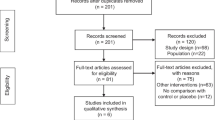Abstract
The primary aim of this systematic review is to evaluate how postural balance and visual system are related in cross-eyed patients. The secondary goal is to assess the benefits of eye realignment on motor skills and body balance. Analyzing two different approaches: surgical or conservative, a systematic literature search was conducted using PubMed–Medline, Google Scholar and Cochrane Central in order to identify randomized controlled trials, case series and case–control studies which contained clinical evaluation of balance in strabismic patients as well as re-evaluation after surgery or conservative treatments via posturography to evaluate surface, length and mean speed of the center of pressure (CoP). A total of 11 studies were included in this review. The MINORS score is used to assess the methodological quality of the included studies, and its mean value was 12.8 for non‐comparative studies and 17.5 for comparative studies. The postural balance was lower in strabismic patients compared with the control group, with statically higher value (p < 0.05) of surface, length and mean speed of the CoP in the study group. All patients show improvement in stability after surgery, as surface, length and mean speed of the CoP decreased after surgery in all the studies with statistical significance (p < 0.05).

Similar content being viewed by others
Data availability
Not applicable.
Code availability
Not applicable.
References
Therrien AS, Bastian AJ (2019) The cerebellum as a movement sensor. Neurosci Lett 688:37–40
Weeks HM, Therrien AS, Bastian AJ (2017) The cerebellum contributes to proprioception during motion. J Neurophysiol 118:693–702
Di Fabio RP, Anderson JH (1993) Effect of sway-referenced visual and somatosensory inputs on human head movement and postural patterns during stance. J Vestib Res Equilib Orientat 3:409–417
Alharbi AA, Johnson EG, Albalwi AA et al (2017) Effect of visual input on postural stability in young adults with chronic motion sensitivity: a controlled cross-sectional study. J Vestib Res 27:225–231
Lions C, Colleville L, Bui-Quoc E et al (2016) Importance of visual inputs quality for postural stability in strabismic children. Neurosci Lett 617:127–133
Van Der Fits IB, Hadders-Algra M (1998) The development of postural response patterns during reaching in healthy infants. Neurosci Biobehav Rev 22:521–526
Ezane M-D, Lions C, Bui Quoc E et al (2015) Spatial and temporal analyses of posture in strabismic children. Graefes Arch Clin Exp Ophthalmol 253:1629–1639
Torp-Pedersen T, Boyd HA, Skotte L et al (2017) Strabismus incidence in a danish population-based cohort of children. JAMA Ophthalmol 135:1047
Siliato F (1971) Amblyopia in infantile strabismus. Prof Inferm 24:134–139
Simonetti A (1967) Strabismus and amblyopia in pediatric and general medical practice. Ann Ottalmol Clin Ocul 93:689–697
Jayakaran P, Mitchell L, Johnson GM (2018) Peripheral sensory information and postural control in children with strabismus. Gait Posture 65:197–202
Laplant J, Vagge A, Nelson LB (2018) Practice patterns in the management of amblyopia: a survey study. J Pediatr Ophthalmol Strabismus 55:100–106
Tailor V, Bossi M, Greenwood JA et al (2016) Childhood amblyopia: current management and new trends. Br Med Bull 119:75–86
Gaertner C, Creux C, Espinasse-Berrod M-A et al (2013) Benefit of bi-ocular visual stimulation for postural control in children with strabismus. PLoS ONE 8:e60341
Legrand A, Bui-Quoc E, Bucci MP (2012) Re-alignment of the eyes, with prisms and with eye surgery, affects postural stability differently in children with strabismus. Graefes Arch Clin Exp Ophthalmol 250:849–855
Przekoracka-Krawczyk A, Nawrot P, Czaińska M et al (2014) Impaired body balance control in adults with strabismus. Vision Res 98:35–45
Bucci MP, Soufi H, Villeneuve P et al (2016) Importance of proprioceptive information for postural control in children with strabismus before and after strabismus surgery. Front Syst Neurosci. https://doi.org/10.3389/fnsys.2016.00067
Lions C, Bui-Quoc E, Bucci MP (2013) Postural control in strabismic children versus non strabismic age-matched children. Graefes Arch Clin Exp Ophthalmol 251:2219–2225
Lions C, Bui Quoc E, Wiener-Vacher S et al (2014) Postural control in strabismic children: importance of proprioceptive information. Front Physiol. https://doi.org/10.3389/fphys.2014.00156
Legrand A, Quoc EB, Vacher SW et al (2011) Postural control in children with strabismus: effect of eye surgery. Neurosci Lett 501:96–101
Odenrick P, Sandstedt P, Lennerstrand G (2008) Postural sway and gait of children with convergent strabismus. Dev Med Child Neurol 26:495–499
Matsuo T, Narita A, Senda M et al (2006) Body sway increases immediately after strabismus surgery. Acta Med Okayama 60:12
Dickmann A, Di Sipio E, Simbolotti C et al (2016) Balance in subjects with congenital or early onset strabismus: influence of age. Neurosci Lett 623:28–35
Funding
This research received no external funding.
Author information
Authors and Affiliations
Contributions
LADB and GC contributed to conceptualization; GFP provided methodology; GG and GM performed formal analysis and investigation; GFP and GM done writing—original draft preparation; LADB and ADZ performed writing—review and editing; RP was involved in funding acquisition; MC provided resources; MC and RP performed supervision.
Corresponding author
Ethics declarations
Conflict of interest
The authors declare that they have no conflict of interest.
Additional information
Publisher's Note
Springer Nature remains neutral with regard to jurisdictional claims in published maps and institutional affiliations.
Rights and permissions
About this article
Cite this article
Papalia, G.F., Mangano, G., Diaz Balzani, L.A. et al. Strabismus and postural control: a systematic review. Musculoskelet Surg 106, 345–356 (2022). https://doi.org/10.1007/s12306-022-00737-y
Received:
Accepted:
Published:
Issue Date:
DOI: https://doi.org/10.1007/s12306-022-00737-y




